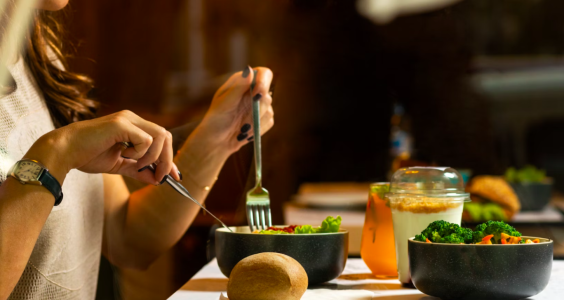Rethinking modern diets: Was the old way actually healthier?
- Replies 0
Things don’t feel the way they used to—especially at the dinner table.
Food isn’t just bigger, it’s become harder to control.
Many are realizing that the habits of the past might be the key to solving today’s health puzzles.
One mother’s journey with her daughter's diagnosis helped uncover what might be a lost secret in plain sight.
The number of fast-food chains has surged dramatically in the past few decades. In the 1970s, there were just a few thousand. Today, that figure is closer to 25,000.
Experts say this explosion in dining options has completely changed how we eat. A bestselling author—who also happens to be a parent of a child diagnosed with a serious illness—shared how a shift away from home-cooked meals made it harder to monitor not only health but everyday behavior.
“I was able to see what every single food did to her,” she said, reflecting on over a decade of tracking blood sugar and insulin. Her experience reveals the toll of modern food on the body.
What many remember as "three square meals" has now turned into constant grazing. Food is everywhere now, and people are snacking more than ever. This nonstop eating interrupts how insulin works and keeps the digestive system under pressure.

Back then, eating out was rare—and when it did happen, meals were balanced and portioned. Now, it's common to have burgers three times the size they once were, and drinks with triple the sugar. For comparison, a soda once held 6.5 ounces.
Today, a standard order is 20 ounces, with calories jumping from 85 to 250.
Families used to cook most of their meals at home, which made it easier to track ingredients and control portions. “When I go out, I seem to overeat because the portions are bigger,” the author said. It’s no surprise that activity levels have plummeted at the same time—less movement, more processed food.
She saw how extreme fluctuations in fat, salt, and sugar from meal to meal made it impossible to predict how her daughter’s body would react. And she knows most parents don’t realize just how much sugar is making its way into their children’s daily lives—whether from playdates, birthday parties, or even classroom “rewards.”
To help families remember what worked, she created a simple rule: the ABCTs. And yes—it’s based on those routines that kept people more active, more consistent, and more balanced just a few decades ago.
Also read: A simple step that changes the odds for colon cancer survivors
A stands for Avoid unhealthy, high-fat and high-sugar foods. She recommends skipping the drive-thru and aiming for more whole foods. Control starts in the kitchen.
B is Be active, especially after eating. She doesn’t say you need to hit the gym—walking after dinner or just moving around helps digestion and energy.
C is Consistency in food choices. She saw that having wildly different meals every day made things harder to manage. Keeping meals simple and familiar helps the body respond predictably.
T is for Timing. Give the body a break between meals, she advises. Breakfast, lunch, and dinner—with one small snack in between—was once the norm, and it worked.
The lessons she learned transformed how her entire household eats. She still prepares most of her meals at home and controls ingredients carefully.
“I eat well and I don’t eat a lot of high sugar and high fat foods,” she said.
“It doesn’t have to be bland, like hospital meals, but it also doesn’t have to all be sprinkled and dipped and battered.”
Also read: Forget the gym! Discover the everyday activities that torch calories faster than exercise!
But there’s another point she wants parents to know: it’s not just about food. It’s also about the way we talk about it. She urges parents to lead by example and shift focus away from numbers on the scale.
Talk about energy, strength, and health instead.
Her daughter—who once needed finger pricks every two hours—has grown into a thriving 26-year-old. Now, she’s passing along the tips that helped make that journey possible. The fast food boom, sedentary habits, and disappearing mealtimes have created a generation struggling to stay healthy.
But it’s not too late to go back. You don’t need a time machine to eat like it’s the 1980s. Just a plan, a pause, and a few smart decisions.
Read next: A little thing called “lifestyle creep” might be ruining your finances. Here’s what you need to know.

Did you grow up with meals made at home? Do you notice how different your energy is when you return to simpler meals? Have you tried the ABCTs or your own version of vintage nutrition? Let us know what’s worked for you.
Food isn’t just bigger, it’s become harder to control.
Many are realizing that the habits of the past might be the key to solving today’s health puzzles.
One mother’s journey with her daughter's diagnosis helped uncover what might be a lost secret in plain sight.
The number of fast-food chains has surged dramatically in the past few decades. In the 1970s, there were just a few thousand. Today, that figure is closer to 25,000.
Experts say this explosion in dining options has completely changed how we eat. A bestselling author—who also happens to be a parent of a child diagnosed with a serious illness—shared how a shift away from home-cooked meals made it harder to monitor not only health but everyday behavior.
“I was able to see what every single food did to her,” she said, reflecting on over a decade of tracking blood sugar and insulin. Her experience reveals the toll of modern food on the body.
What many remember as "three square meals" has now turned into constant grazing. Food is everywhere now, and people are snacking more than ever. This nonstop eating interrupts how insulin works and keeps the digestive system under pressure.

Rethinking modern diets: Was the old way actually healthier? Image Source: Farhad Ibrahimzade / Unsplash
Back then, eating out was rare—and when it did happen, meals were balanced and portioned. Now, it's common to have burgers three times the size they once were, and drinks with triple the sugar. For comparison, a soda once held 6.5 ounces.
Today, a standard order is 20 ounces, with calories jumping from 85 to 250.
Families used to cook most of their meals at home, which made it easier to track ingredients and control portions. “When I go out, I seem to overeat because the portions are bigger,” the author said. It’s no surprise that activity levels have plummeted at the same time—less movement, more processed food.
She saw how extreme fluctuations in fat, salt, and sugar from meal to meal made it impossible to predict how her daughter’s body would react. And she knows most parents don’t realize just how much sugar is making its way into their children’s daily lives—whether from playdates, birthday parties, or even classroom “rewards.”
To help families remember what worked, she created a simple rule: the ABCTs. And yes—it’s based on those routines that kept people more active, more consistent, and more balanced just a few decades ago.
Also read: A simple step that changes the odds for colon cancer survivors
A stands for Avoid unhealthy, high-fat and high-sugar foods. She recommends skipping the drive-thru and aiming for more whole foods. Control starts in the kitchen.
B is Be active, especially after eating. She doesn’t say you need to hit the gym—walking after dinner or just moving around helps digestion and energy.
C is Consistency in food choices. She saw that having wildly different meals every day made things harder to manage. Keeping meals simple and familiar helps the body respond predictably.
T is for Timing. Give the body a break between meals, she advises. Breakfast, lunch, and dinner—with one small snack in between—was once the norm, and it worked.
The lessons she learned transformed how her entire household eats. She still prepares most of her meals at home and controls ingredients carefully.
“I eat well and I don’t eat a lot of high sugar and high fat foods,” she said.
“It doesn’t have to be bland, like hospital meals, but it also doesn’t have to all be sprinkled and dipped and battered.”
Also read: Forget the gym! Discover the everyday activities that torch calories faster than exercise!
But there’s another point she wants parents to know: it’s not just about food. It’s also about the way we talk about it. She urges parents to lead by example and shift focus away from numbers on the scale.
Talk about energy, strength, and health instead.
Her daughter—who once needed finger pricks every two hours—has grown into a thriving 26-year-old. Now, she’s passing along the tips that helped make that journey possible. The fast food boom, sedentary habits, and disappearing mealtimes have created a generation struggling to stay healthy.
But it’s not too late to go back. You don’t need a time machine to eat like it’s the 1980s. Just a plan, a pause, and a few smart decisions.
Read next: A little thing called “lifestyle creep” might be ruining your finances. Here’s what you need to know.
Key Takeaways
- Meals in the 1980s were smaller, home-cooked, and more consistent, supporting better health and blood sugar control.
- Today’s fast-food boom and portion sizes have made it harder to maintain stable energy and healthy weight.
- The ABCTs—Avoid, Be active, Consistency, and Timing—can bring back simple eating habits that work.
- Parents can lead by example by cooking more, focusing on health over appearance, and involving kids in food decisions.






